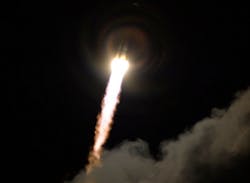ESA's billion-pixel Gaia surveyor blasts off, on its way to the L2 Lagrange point
Kourou, French Guiana--The European Space Agency's (ESA's) Gaia mission blasted off this morning (19 December, 2013) on a Soyuz rocket from ESA's spaceport in French Guiana.
Designed to create the most accurate map yet of the Milky Way, Gaia will make accurate measurements of the positions and motions of 1% of the total population of roughly 100 billion stars in the Milky Way galaxy. Gaia's focal-plane array (FPA) has almost a billion pixels, with the FPA's many individual CCD arrays grouped into specific functions. Gaia's CCD sensors were all produced by e2v (Chelmsford, England).
The Soyuz launcher, operated by Arianespace, lifted off at 09:12 GMT. About ten minutes later, after separation of the first three stages, the Fregat upper stage ignited, delivering Gaia into a temporary parking orbit at an altitude of 175 km. A second firing of the Fregat 11 minutes later took Gaia into its transfer orbit, followed by separation from the upper stage 42 minutes after liftoff. Ground telemetry and attitude control were established by controllers at ESA's operations centre in Darmstadt, Germany, and the spacecraft began activating its systems.
The sunshield, which keeps Gaia at its working temperature and carries solar cells to power the satellite, was deployed in a 10 minute automatic sequence, completed around 88 minutes after launch. Gaia is now en route towards an orbit around a gravitationally-stable virtual point in space called L2, some 1.5 million km beyond Earth as seen from the Sun.
Tomorrow, engineers will command Gaia to perform the first of two critical thruster firings to ensure it is on the right trajectory towards its L2 home orbit. About 20 days after launch, the second critical burn will take place, inserting it into its operational orbit around L2. A four-month commissioning phase will start on the way to L2, during which all of the systems and instruments will be turned on, checked and calibrated. Then Gaia will be ready to begin its five-year science mission.
Gaia will observe each of the billion stars it is targeting an average of 70 times each over the five years. It will measure the position and key physical properties of each star, including its brightness, temperature, and chemical composition. By taking advantage of the slight change in perspective that occurs as Gaia orbits the Sun during a year, it will measure the stars’ distances and, by watching them over the whole mission, their motions across the sky.
The motions of the stars can be put into "rewind" to learn more about where they came from and how the Milky Way was assembled over billions of years from the merging of smaller galaxies, and into "fast forward" to learn more about its ultimate fate.
After five years, the data archive will exceed 1 petabyte.

John Wallace | Senior Technical Editor (1998-2022)
John Wallace was with Laser Focus World for nearly 25 years, retiring in late June 2022. He obtained a bachelor's degree in mechanical engineering and physics at Rutgers University and a master's in optical engineering at the University of Rochester. Before becoming an editor, John worked as an engineer at RCA, Exxon, Eastman Kodak, and GCA Corporation.
